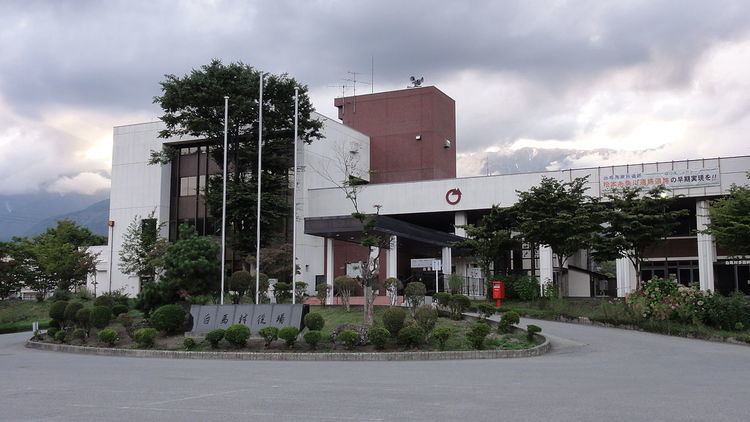Country Japan Prefecture Nagano Phone number 0261-72-5000 | Region Chūbu (Kōshin'etsu) District Kitaazumi | |
 | ||
Time zone Japan Standard Time (UTC+9) | ||
Hakuba (白馬村, Hakuba-mura) is a village located in Kitaazumi District in far northwest Nagano Prefecture, in the Chūbu region of Japan. As of 1 October 2016, the village had an estimated population of 8,789 and a population density of 46.4 persons per km². Its total area was 189.36 square kilometres (73.11 sq mi). Hakuba is an internationally renowned ski resort town in the northern Japan Alps. As the surrounding valley has an annual snow fall of over 11 meters, it is the central hub for 10 ski resorts with more than 200 runs. The village was the main event venue for 1998 Winter Olympics (Alpine, Ski Jump, Crosscountry).
Contents
- Map of Hakuba Kitaazumi District Nagano Prefecture Japan
- Geography
- Surrounding municipalities
- Climate
- History
- Economy
- Education
- Railway
- Highway
- International relations
- Local attractions
- Ski resorts
- In popular culture
- References
Map of Hakuba, Kitaazumi District, Nagano Prefecture, Japan
Geography
Hakuba is located in the mountainous far northwestern Nagano Prefecture, bordered by Toyama Prefecture to the west. Much of the village is within the borders of the Chūbu-Sangaku National Park.
Surrounding municipalities
Climate
Hakuba receives approximately 11 meters of snowfall annually, with most snowfall occurring in the months of January and February.
Hakuba has a humid continental climate (Köppen Dfa), with cold, extremely snowy winters, and warm, rainy summers. With temperatures cooled by the elevation, monthly 24-hour average temperature ranges from −3.0 °C (26.6 °F) in January to 22.6 °C (72.7 °F) in July.
History
The area of present-day Hakuba was part of ancient Shinano Province and was part of the territory controlled by Matsumoto Domain under the Tokugawa shogunate of the Edo period. Hakuba was once part of the route called the Salt Road used to bring salt and other marine products from the coast.
The modern village of Hakuba was established on September 30, 1956 by the merger of the villages of Hokujo and Kamishiro.
Hakuba and surrounding municipalities were impacted by a reported 6.7 magnitude earthquake on 22 November 2014. The quake hit at 10:08pm at a depth of 5 km causing a number of residential properties to collapse and injuring at least 41 people. Despite some localized road damage and a suspension of rail services on sections of the Ōito Line, there was however no major impact on hotels or ski tourism related infrastructure.
Economy
The economy of Hakuba is heavily dependent on seasonal tourism.
Education
Hakuba has two public elementary schools and one public middle school operated by the village government. The village has one public high school operated by the Nagano Prefectural Board of Education.
Railway
Highway
International relations
Local attractions
Surrounded by the Sea of Japan (northward), Nagano City (eastward) and the Tateyama Kurobe Dam area (southward), Hakuba is also a popular summer vacation area which offers a variety of outdoor activities at an altitude of 700–800 metres, e.g. hiking, rafting/shower climbing, paragliding, mountain bike, bird sighting etc.
Ski resorts
The Hakuba Valley incorporates 11 ski resorts that offer an expanse of terrain. The Hakuba ski resorts aren’t interconnected via the slopes (except for Hakuba 47 and Goryu, and Cortina and Norikura), but they can be accessed off a common lift ticket and there are free shuttle buses to get around to the different ski areas. The ski resorts from north to south are: Cortina, Norikura, Tsugaike Kogen, Iwatake, Happo-One, Hakuba 47, Goryu, Sanosaka, Kashimayari, Jigatake, and Minekata is on the opposite side of the valley from the town of Hakuba.
One major advantage of Hakuba is the terrain size on offer with 960 hectares of skiable terrain which equates to 137km of piste and 200+ courses, 135 lifts (5 gondolas) and at least 9 terrain parks.
The Hakuba skiing is varied across the resorts but it’s generally very well suited to beginners and intermediates with many long perfectly groomed runs and fantastic fall-line.
